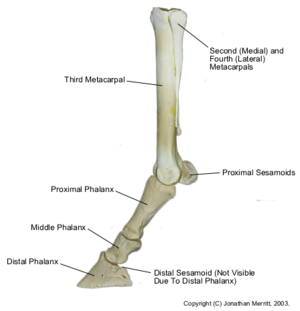
I had been away from horses for ten very long years when I decided to make a huge life change and come back to school. The first class in my program, Introduction to Equine Science, is open to both majors and non-majors. I had no idea what to expect when I walked into the large lecture room in Johnson Hall that first day in August. Now sixteen weeks later with the final exam and lab practicum under my belt, I thought I’d wax poetic about some of my favorite parts.
There was a moment of sheer terror during the first week when Dr. Denniston, one of our faculty members, a national and inter- nationally sought after horse conformation judge and advisor to the horse judging teams, was giving the anatomy and conformation lecture. He made a passing remark assuming the entire class knew all the bones in the horse’s foreleg and their relationship to stride length. Wow! I have a lot of catching up to do here, I thought to myself. I mean I’m in there with people who are way beyond me in horse experience. I rode as a kid for many years and then had a long break before riding again ten years ago. But my classmates have done everything from years of 4-H participation to owning horses, breeding them, and training them all their lives.
I went home and read the book, made flash cards; I mean the whole nine yards.
Look, I quit my job, drove halfway across the country with my pets and my stuff; there was just no turning back! The next day I got a text message that said “Pop quiz…name the bones in the foreleg.” I nearly had a stroke. I actually thought it was my professor, but it was my new friend Erin. Well of course I had already answered back before I figured that out!
That solid foundation that Dr. Denniston wanted us to have has served me well all term whether that has been knowing the bones, their ideal angles, being able to evaluate a horse’s conformation, or knowing ways to attack my studying. Over the term, we’ve had guest faculty lectures on everything from equine reproduction—which went way beyond anything you learned in your health classes, let me tell you—to careers in the industry, nutrition, equine law, the roll of the Bureau of Animal Protection, horse behavior, diseases, the list is really quite extensive. While all the lectures were informative and the enthusiasm of the speakers was definitely exciting, it was the hands on learning out at the Equine Center that truly made this class amazing.
In one lab with our instructor Ryan Brooks and guest lecturer Cassidy Kurtz, we did an experiment to see if exercise could increase in the oxygen carrying

red blood cells in the horse. We took blood samples before exercise, attached a heart rate monitor, and slowly increased the intensity of the workout before drawing a second blood sample just after the exercise peak. After the cool down phase, we waited to see how long it took the horse to return to a resting heart rate. In this one lab we learned about heart rate, exercise intensity, and how the horse can increase oxygen in its blood by relying on red blood cell reserves stored in the spleen which are released by splenic contraction during intense exercise.
On another day, our lab co-instructor, Sarah Matlock, showed us how the drive line works in a horse. How just by standing in front of the shoulder line while lunging the horse in a circle slows their forward movement makes them stop, and stepping behind that line moves them forward. She did it so effortlessly it looked like she was communicating telepathically with the horse.
For our lab about reproduction we actually went to the Equine Reproduction Laboratory and watched Dr. Bruemmer and his team collect a sample from a stallion. Everything we had learned in lecture played out fifteen feet in front of us from the reactions of the mare and the stallion, to the moment of collection. Then we walked around the corner into the laboratory and saw how extender, made of milk, sugar and antibiotics, was added to the sample to help keep it viable. Then it was tested for three different qualities: volume, concentration, and motility of the sperm. We calculated how many breeding doses we could get from this sample. Then we went down the hall to another area where a mare was waiting and we watched Dr. Breummer deftly guide the ultrasound wand into the mare so we could see her reproductive tract. There’s nothing like seeing the entire process to help you appreciate what goes on in artificial insemination or help you study for an exam about it.
After learning about equine diseases from Dr. Hess in lecture, our lab about health and first aid taught us how to do a basic health assessment, and use a stethoscope to find the horse’s heartbeat. We did a capillary refill test on the gums to check for health, took his temperature, counted respiration, and listened to gut sounds. In our take home assignment we learned about core vaccines that horses need for protection against common diseases, as well as their proper storage, and administration.

Our primary instructor Ryan Brooks and our lab teaching assistant, Brittany Johnson, took time after our lab on equine hoof care to help me understand what a contracted heel looked like and learn to confidently pick up the horse’s front and back feet for inspection—which I haven’t done since I was 12. I could tell you a million more stories about everything I learned this term from just this one class, and all the care and attention our faculty offered each of us to help us succeed, but I’ll save them for another time. I can tell you I have definitely gotten a foundation in equine science and I can hardly wait for next term to start. However, I know the horses need a break just as much as we do to let all this new information sink in.






